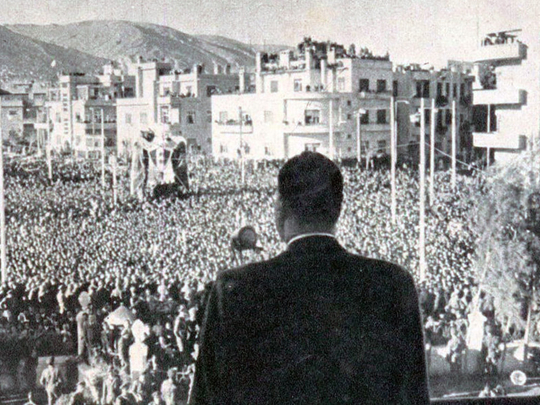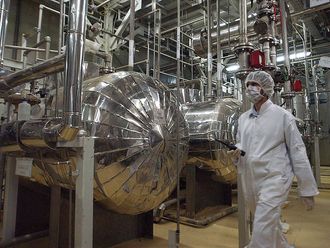
Damascus: “His eyes glimmered in a remarkable manner, projecting confidence and superb intelligence”, a retired Syrian cabinet minister recounted.
Ahmad Abdul Karim, 90, tells Gulf News about his first meeting with President Gamal Abdul Nasser in Cairo, back in 1955 while he was an officer.
He was part of a delegation headed by then-Prime Minister Said Al Ghazzi, charged with signing the Syrian-Egyptian Defense Pact.
- Ahmad Abdul Karim, retired Syrian cabinet minister
Nasser invited his Syrian guests to dinner and spoke about the need to unify the Arab front.
“His words touched me. From the tone of his voice, you could tell he was honest. He made a point to speak with every member of the Syrian delegation, making each of us feel that we had known him for a long time and that we had a special place in his heart. That is what I felt.”
Three years later, another delegation led by Army Commander Afif Al Bizri went to Egypt—this time without government authorisation,
• Egyptians remember ‘father of the poor’
• Jamal Abdul Nasser left behind immortal legacy
• Timeline: Abdul Nasser’s life in short
• Nasser’s revolutionary spirit passed onto his children
Al Bizri pleaded with Nasser to merge his country with Syria.
He agreed and the United Arab Republic (UAR) was formed in February 1958.
For the first time in his life, Nasser traveled to Damascus where he signed the creation of the union with then-president Shukri Al Quwatli.
Retired officer Nasser Qaddour, now 85, was there when the signing took place.
- Nasser Qaddour, retired Syrian officer
“I was charged with his security at the Qasr Al Diyafa Palace on the tip of Abu Rummaneh Street. I accompanied him from the airport to central Damascus,” he told Gulf News.
“The masses adored him. Thousands turned out to greet him when he came to Syria, filling streets, squares, balconies and rooftops. They weren’t just Syrians but Arabs as well; Lebanese, Iraqis, and Palestinians. Every half hour he would appear on the palace balcony with a brief speech, and the people would go crazy. This continued until after midnight, when somebody came out and told the masses: ‘Please go home and let the President get some rest.”
Nasser appointed Qaddour as Director of General Intelligence in the Northern Province of the UAR (as Syria was called in 1958-1961).
He later became a lawmaker after the collapse of the union.
Abdullah Al Khani, then secretary-general of the Syrian Presidency recalls: “The happiness of Damascus cannot be described. People just wanted to see their hero. I recall several women rushing to shake hands with him,” the 92-year-old told Gulf News.
Al Khani went on to serve as a diplomat in London and Paris, before joining the International Court of Justice at The Hague.
In September 1970, he was the one to announce Nasser’s death at the General Assembly of the United Nations.
The testimonies of all four Syrians on Nasser are among the very last among contemporaries of the late Egyptian leader. A forth Syrian associate, Jassem Alwan, 90, died in Cairo on 3 January 2018. A Nasserist to the bone, he had tried to launch a coup against the Baathists, shortly into their rule, in July 1963. A military court sentenced him to death and he remained a guest of the Egyptian government for 55-years. Back in September 2013, Nasser’s former Syrian Vice-President Abdul Hamid Sarraj died in Cairo, aged 83. He was the infamous director of Syrian intelligence during the pre-union years, who remained in Cairo from 1961 until 2013.











